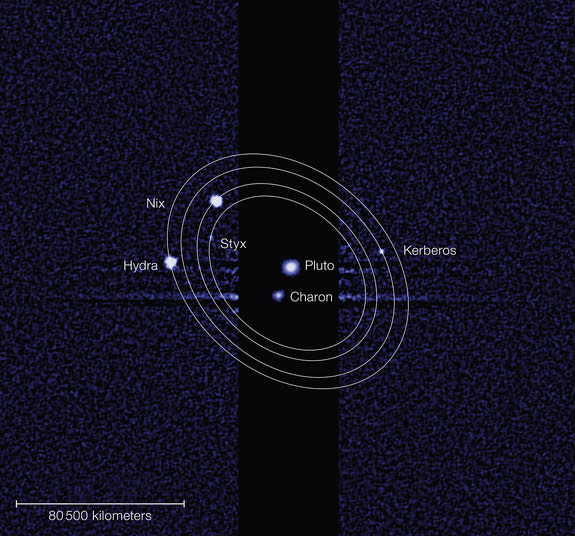 Science and Weather
Science and WeatherPluto’s newest moons now called Kerberos and Styx

After a few months of deliberation, the International Astronomical Union announced today that it had finally assigned official names to the two newest of Pluto's moons (at least that we've found so far).
Now, in addition to Charon, Nix and Hydra, say "hello" to Kerberos and Styx.
You might remember a few months ago, when the people at SETI — the Search for Extra Terrestrial Intelligence — put together a contest called 'Pluto Rocks', to name these two (formerly called 'P4' and 'P5', respectively) by asking the public to both enter suggestions and to vote on them.
[ Related: Russian rocket launch ends in fiery explosion ]
William Shatner stepped up to champion the cause for one of them to be named Vulcan, but not just because of his association with Star Trek. His reasoning is that the Roman god, Vulcan (the god of volcanism) is the nephew of Pluto, the god of the Underworld. It seemed that plenty of people liked his idea, because the name skyrocketed to the top of the list. Cerberus (the three-headed dog that guards the gates of the Underworld) came in second place, and Styx came in third.
However, after going through the 'winning' names from the contest, the IAU decided to reject Vulcan, due to it being used already — well, sort of.
Again, this isn't a Star Trek reference, but it's equally fictitious. Back in the mid-1800s, astronomers were trying to reconcile the strangeness of Mercury's orbit with Newton's Laws of Motion (if you were to watch it from above, the planet traces out an orbit that looks a bit like those simple flower-petal 'spirograph' drawings). One of the proposed solutions was that there could be a tiny planet between Mercury and the Sun that could be disturbing its orbit (finding these kinds of 'disturbances' in the orbits of Jupiter and Saturn led astronomers to discover Uranus, Neptune and Pluto). This hypothetical planet was given the name Vulcan.
Einstein solved the problem with Mercury's orbit when he published his General Theory of Relativity, but the name is still 'on the books' as having been used.
So, moving down the list, there was Cerberus and Styx, but then they ran into another overlap — this one being a bit more solid.
You see, there's an Apollo asteroid (the type that crosses Earth's orbit), that's over a kilometre wide, called 1865 Cerberus, so using that name again would just cause confusion. However, rather than continuing to push further down the list, the Greek 'version' of Cerberus — Kerberos — has yet to be used for anything astronomical, so that was a perfect compromise.
[ More Geekquinox: Sweltering heat breaks records across Western Canada ]
With astronomers predicting even more moons orbiting tiny Pluto (or, if you're like me, the binary-planet duo of Pluto and Charon), and the New Horizons spacecraft set to arrive there in just over two years, we'd better get to work expanding out that list, so maybe we can have a batch of pre-authorized names ready to go once the new pictures start streaming in.
Geek out with the latest in science and weather.
Follow @ygeekquinox on Twitter!


